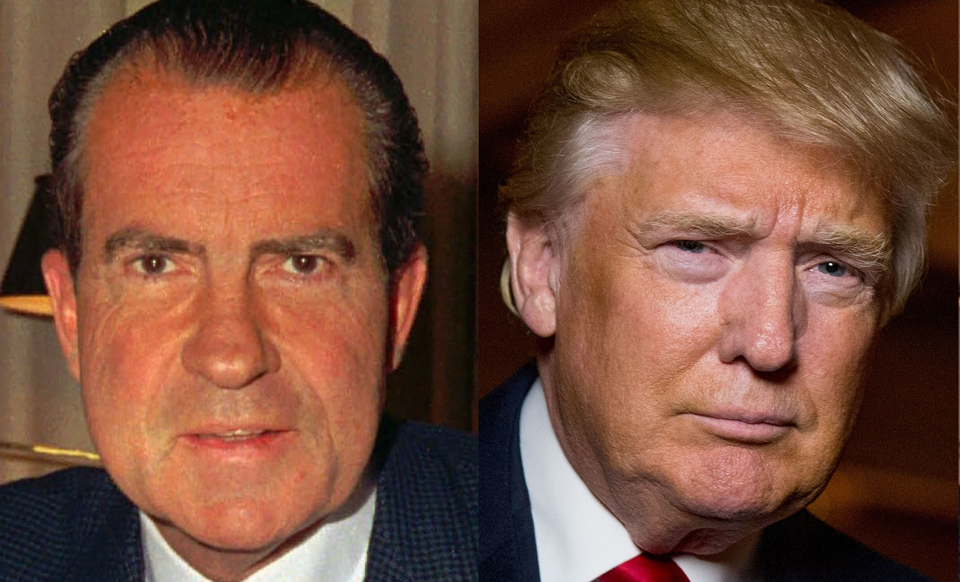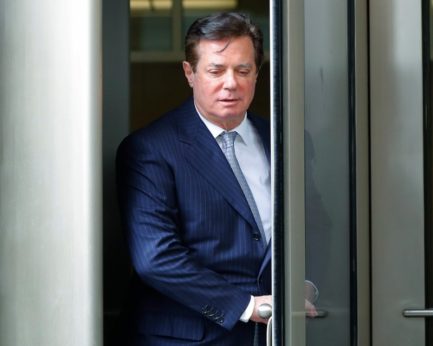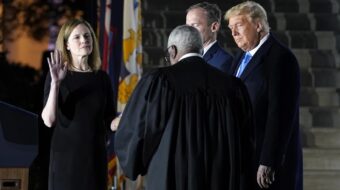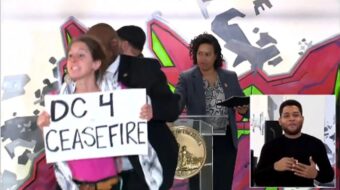
WASHINGTON—It’s been 44 years, come August 8-9, 1974, since Republican President Richard M. Nixon resigned in disgrace – before being thrown out of the Oval Office via impeachment and conviction – due to the accumulated scandals, constitutional crimes and cover-ups collectively known as Watergate.
And now, the parallels to that era, but this time involving Republican President Donald J. Trump, are getting pretty long, and pretty obvious.
The only thing missing so far? A Congress, with the notable exception of the Senate Intelligence Committee, willing to undertake the serious business of investigating the whole mess.
Consider some of the developments:
- Trump Campaign Chairman Paul Manafort went on trial for being a “bagman” of sorts, starting with jury selection on July 31. The trial is expected to last three weeks.
Manafort faces 35 witnesses to be called by Special Counsel Robert Mueller. Mueller seeks to prove, in so many words, that the Russian Federation – read, President Vladimir Putin — paid Manafort to lobby for U.S. approval of its numerous depredations. Mueller, perhaps more importantly, charged Manafort with 18 counts of tax fraud and money laundering.
In 1974, Nixon’s finance chairman, Maurice Stans, went on trial for being a “bagman,” collecting millions in undisclosed campaign cash from big givers and U.S. corporations – the corporate contributions were illegal – in return for promise of government favors.
And, just like in Watergate, deputies are singing to the prosecutors: Jeb Stuart Magruder, Nixon’s deputy campaign chairman, and others, in the 1974 Watergate cover-up trial, though not in the Stans case; Rick Gates, Manafort’s deputy in the Trump campaign, and Trump’s former National Security Adviser, Michael Flynn, now.
- Just like in Watergate, U.S. District Judge T.S. Ellis in Alexandria is known for intolerance of nonsense in his court. In 1973, aggressive questioning by U.S. District Judge John J. Sirica of D.C., another no-nonsense jurist, pushed one of the burglars, former CIA man James McCord, to break the cover-up. That started the ball rolling towards the real trial, the next year. Republican presidents nominated both Sirica (Eisenhower) and Ellis (Reagan).
- The FBI’s Nixon probe started after police arrested former CIA operative Howard Hunt, a White House aide, Nixon campaign official G. Gordon Liddy and six so-called anti-Castro Cuban burglars at and after the break-in at the Democratic National Committee’s offices in the Watergate office building. The burglars sought political dirt on party chair Larry O’Brien, Sen. Edward M. Kennedy, D-Mass., and Sen. George McGovern, D-S.D., the leading Democratic presidential contender.
- The FBI, which pursued the case against Nixon despite the president’s cover-up, discovered and disclosed the Russians’ burglary on Trump’s behalf. Unlike Watergate, this one succeeded. The Russians hacked the DNC computers, along with those of the party’s Senate and House campaign committees and presidential nominee Hillary Clinton. The Russians sought dirt on her, too. Then they disclosed it, via selective leaks of thousands of e-mails to Wikileaks.
- Carl Bernstein and Bob Woodward are on the Trump story. Yes, THAT Carl Bernstein and THAT Bob Woodward, the Washington Post reporters who exposed – and exploded – the Watergate break-in and cover-up.
Bernstein co-bylined a CNN story in late July about Trump’s lawyer/fixer Michael Cohen telling Mueller that Trump knew about a meeting in July 2016, during the presidential campaign, in Trump Tower, between his sons and Russian reps saying they had dirt on Clinton.
It’s all on Cohen’s tapes. What’s on Cohen’s tapes “goes to the question of intent to collude” by Trump, Bernstein told CNN.
Which is another parallel: Nixon ultimately had to quit when his tapes showed he ordered the Watergate cover-up.
Meanwhile, Woodward will publish another insider book on White House scheming, Fear: Trump in the White House, this Sept. 11, publisher Simon & Schuster announced on July 30.
- Nixon OKed the Watergate cover-up, six days after the burglars were arrested on June 17, 1972. His staff set up the burglary team long before. Putin ordered the computer “burglary” – the hacking — of Clinton, the DNC, and other Democratic computers, telling his staff in 2016 to aid Trump’s presidential bid. Putin admitted it at the infamous Helsinki press conference with Trump in mid-July.
Trump declared during the 2016 campaign: “If the Russians are listening, I hope they find those 30,000 emails” allegedly missing from Clinton’s computer server. The Russian hacking started that night.
- Watergate went beyond the Watergate, to the break-in at the psychiatrist’s office of Daniel Ellsberg, discloser of the Pentagon Papers. The Russian hacking goes beyond 2016, to now: Sen. Claire McCaskill, D-Mo., facing a close re-election race in the Show Me State, recently disclosed – and stopped – Russian hacking of her office and campaign computers. Trump’s own Director of National Intelligence, former Indiana Sen. Dan Coats, warns the Russian hacking continues to this day.
- Nixon tried to foster the cover-up by summarily firing Special Prosecutor Archibald Cox and throwing an FBI cordon around the special prosecution force’s offices in October 1973. Public uproar about “the Saturday Night Massacre” – the U.S. Capitol switchboard broke down under the flood of angry phone calls, and lawmakers were inundated with telegrams – forced him to back down and guarantee another independent special prosecutor, Leon Jaworski.
Trump first fired FBI Director James Comey for refusing to close down the Russian hacking probe. And, as subsequent reports show, Trump knew two weeks before his own inauguration that the Russians did the hacking, but has lied about it ever since. Top U.S. intelligence officials gave him the details during a January 2017 briefing at Trump Tower. Meantime, Trump tweets and complains constantly to discredit Mueller and his boss, Deputy Attorney General Rod Rosenstein, and the entire Justice Department.
- There are tapes of cover-up planning involving Nixon and tapes of cover-up planning involving Trump. Nixon’s tapes disclosed his participation in the Watergate cover-up. “I don’t give a shit what happens. I want you all to stonewall it. Let them plead the 5th Amendment, cover up or anything else that will save the plan. That’s the whole point,” he told his former Attorney General, John Mitchell, who as his campaign chairman was a Watergate co-conspirator.

Paul Manafort, Trump’s campaign chairman after he was charged with numerous high crimes. | AP
Nixon taped himself and his aides. Cohen taped his talks with Trump about turning over cash – or checks – worth $150,000 to cover-up a prior Trump affair with Playboy playmate Karen McDougal. Nixon, remember, OKed $1 million in cash to buy the silence of Hunt, Liddy and the six burglars.
- “I am not a crook,” Nixon told an Associated Press editors’ conference almost a year after the Watergate break-in. “Collusion is not a crime,” Trump tweeted, again, on July 31.
- Trump tweeted and Trump lawyer Rudy Giuliani alleged on CNN on July 31 that Mueller has “a conflict of interest” due to a past “nasty and contentious business relationship” with Trump. Asked directly “What’s the conflict?” Giuliani replied: “I can’t tell you. I’m not sure I know exactly what the conflict is.”
The Watergate parallel: In 1974, Nixon left his White House counsel, Fred Buzhardt, his lawyer, James St. Clair, and his 11 GOP supporters on the House Judiciary Committee in the dark about the “smoking gun” tape of him ordering the cover-up just after the arrests for the break-in.
All of this produces a sense of déjà vu, and not just for journalists. Former Deputy Watergate Special Prosecutor Jill Wine Volner, now Jill Wine Banks, told MSNBC in late July that all the details “sent chills down my spine.” And there’s one more parallel, the Chicago-area native said, that may or may not come true.
The U.S. Supreme Court, with three Nixon-appointed justices, ruled 8-0 Nixon had to give up his tapes, including the “smoking gun” tape. Nixon resigned days later, after reluctantly saying, “I respect and accept the court’s decision” to order him to turn over the tapes to Judge Sirica.
Volner isn’t so sure Trump will follow the same course, if it comes to that.
“We definitely worried about what we would do if he (Nixon) did not comply” with the High Court’s ruling, Volner told MSNBC. “That would have been an issue.”
“What worries me now is that with this president, you don’t know if he has any respect for the rule of law. He might not comply.”

MOST POPULAR TODAY

High Court essentially bans demonstrations, freedom of assembly in Deep South

Zionist organizations leading campaign to stop ceasefire resolutions in D.C. area

U.S. imperialism’s ‘ironclad’ support for Israel increases fascist danger at home

UN warns that Israel is still blocking humanitarian aid to Gaza







Comments